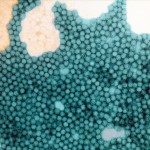Link to HAL – hal-04874546
Link to DOI – 10.1099/acmi.0.000886.v3
Access Microbiology, 2025, ⟨10.1099/acmi.0.000886.v3⟩
To date, data on animal enteroviruses (EVs) are scarce, especially in Central Africa. The aim of this study was to characterize EVs among pigs and goats in Cameroon and the Central African Republic (CAR). A total of 226 pig and goat faecal samples collected in two previous studies carried out in Cameroon and CAR were pooled and screened with molecular assays targeting EV-Es, EV-Fs and EV-Gs. EV genomes were amplified by RT-PCR and their sequences were obtained by Illumina sequencing and de novo assembly. Based on the capsid sequences, 27 EV-G sequences were identified and assigned to 11 virus types, while no EV-E or EV-F was observed. Phylogenetic analysis revealed that the EV-Gs detected in Central Africa do not form specific clusters compared to EV-Gs previously reported in other continents. This suggests a worldwide circulation of EV-Gs, which is likely due to the massive international trade of live animals. One human EV, EV-C99, which belongs to the species Enterovirus C, was detected in pigs. This is the third detection of such an event in a similar context, reinforcing the hypothesis that some EV-Cs could be infecting pigs. Our work provides new data on the genetic diversity of EVs circulating among domestic animals in Central Africa.









